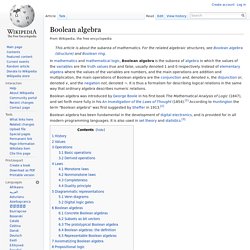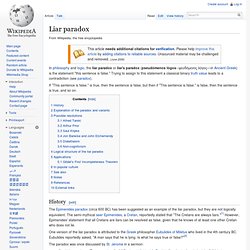

'Truth or Lies' Brain Teaser. Truth or Lies Logic puzzles require you to think.

You will have to be logical in your reasoning. You are traveling down a path and come to a fork in the road. A sign lays fallen at the path indicating that one path leads to a village where everyone tells the truth and the other to a village where everyone tells lies. The sign has been knocked down so you do not know which path leads to which village. Answer You point to either path and say, "Are you from this village? " Philip S. Thomas. Critical thinking web. Boolean algebra. Boolean algebra was introduced by George Boole in his first book The Mathematical Analysis of Logic (1847), and set forth more fully in his An Investigation of the Laws of Thought (1854).[1] According to Huntington the term "Boolean algebra" was first suggested by Sheffer in 1913.[2] Boolean algebra has been fundamental in the development of digital electronics, and is provided for in all modern programming languages.

It is also used in set theory and statistics.[3] History[edit] In the 1930s, while studying switching circuits, Claude Shannon observed that one could also apply the rules of Boole's algebra in this setting, and he introduced switching algebra as a way to analyze and design circuits by algebraic means in terms of logic gates. Shannon already had at his disposal the abstract mathematical apparatus, thus he cast his switching algebra as the two-element Boolean algebra. Values[edit] Operations[edit] Basic operations[edit] The basic operations of Boolean algebra are as follows. J. Liar paradox. In philosophy and logic, the liar paradox or liar's paradox (pseudómenos lógos--ψευδόμενος λόγος—in Ancient Greek) is the statement "this sentence is false.

" Trying to assign to this statement a classical binary truth value leads to a contradiction (see paradox). If "This sentence is false. " is true, then the sentence is false, but then if "This sentence is false. " is false, then the sentence is true, and so on. History[edit] The Epimenides paradox (circa 600 BC) has been suggested as an example of the liar paradox, but they are not logically equivalent. The semi-mythical seer Epimenides, a Cretan, reportedly stated that "The Cretans are always liars One version of the liar paradox is attributed to the Greek philosopher Eubulides of Miletus who lived in the 4th century BC. The paradox was once discussed by St. "I said in my alarm, 'Every man is a liar! ' Explanation of the paradox and variants[edit]
Combinations and Permutations. What's the Difference?

In English we use the word "combination" loosely, without thinking if the order of things is important. In other words: So, in Mathematics we use more precise language: In other words: A Permutation is an ordered Combination. Permutations There are basically two types of permutation: Repetition is Allowed: such as the lock above. 1. These are the easiest to calculate. When we have n things to choose from ... we have n choices each time! When choosing r of them, the permutations are: n × n × ... (In other words, there are n possibilities for the first choice, THEN there are n possibilites for the second choice, and so on, multplying each time.) Which is easier to write down using an exponent of r: n × n × ... Example: in the lock above, there are 10 numbers to choose from (0,1,...9) and we choose 3 of them: 10 × 10 × ... (3 times) = 103 = 1,000 permutations So, the formula is simply: 2.
Binomial Distribution. To understand binomial distributions and binomial probability, it helps to understand binomial experiments and some associated notation; so we cover those topics first.

Binomial Experiment A binomial experiment (also known as a Bernoulli trial) is a statistical experiment that has the following properties: The experiment consists of n repeated trials. Each trial can result in just two possible outcomes. We call one of these outcomes a success and the other, a failure. Consider the following statistical experiment. The experiment consists of repeated trials. Notation The following notation is helpful, when we talk about binomial probability. The normalcdf( Command - TI-Basic Developer. Command Summary Finds the probability for an interval of the normal curve.

Command Syntax normalcdf(lower, upper [, μ, σ]) Menu Location Press: 2ND DISTR to access the distribution menu2 to select normalcdf(, or use arrows. Calculator Compatibility Token Size 2 bytes normalcdf( is the normal (Gaussian) cumulative density function. There are two ways to use normalcdf(. For the standard normal distribution :normalcdf(-1,1 for the normal distribution with mean 10 and std. dev. 2.5 :normalcdf(5,15,10,2.5 Often, you want to find a "tail probability" - a special case for which the interval has no lower or no upper bound.